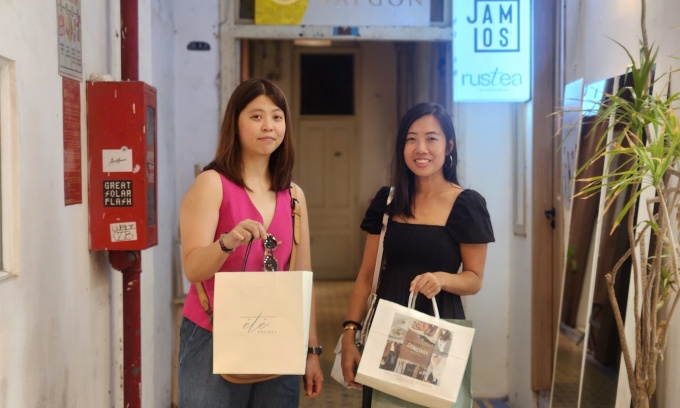Foreign tourists say shopping in HCMC cheaper than Bangkok
The two women came to HCMC for a four-day trip in early October mainly for buying clothes.
Instead of visiting tourist hotspots like Ben Thanh Market and Times Square in District 1, they explored old apartment complexes and residential areas to look for stores selling second-hand goods and local brands.
“On the first day I visited three or four stores in the apartment building at 26 Ly Tu Trong in District 1 and spent more than US$80, all on local brands and second-hand goods,” Goh says.
She points out that HCMC has an increasing number of fashion stores selling gorgeous stuff with a wide variety of options, made from high-quality fabrics and at affordable prices.
“A local brand of T-shirt in Thailand costs 800 to over 1,000 baht (US$24-30), but in HCMC, it is almost half the price, with plenty of options.
“The shopping experience in HCMC is not inferior to Bangkok.”
Some shopping complexes in the Vietnamese city are well organized and less crowded with tourists than in Bangkok, she says.
Amanda Chai, a Straits Times correspondent, recently visited HCMC and was impressed by the shopping experience there and its prices that are only half those of Singapore.
During her four-day trip she spent two times the S$300 she had budgeted on clothes.
Many foreign tourists share videos on social media reviewing shopping spots in HCMC.
A group of foreign tourists look for second-hand goods at a shop in District 1, HCMC. Photo courtesy of Vintage Heart 90s |
“I wish I had known earlier that HCMC has many second-hand shops with great prices,” Cabi, a content creator from Malaysia, says in a video reviewing the shops she visited in July.
Cabi runs a TikTok channel with nearly 250,000 followers, and her video on her shopping experience in HCMC attracted 24,000 likes.
The apartment building on Ly Tu Trong Street has five floors with many small shops that mainly sell second-hand goods and local brands.
It has become a popular destination for foreign tourists, attracting visitors from places like Singapore, Malaysia, Thailand, South Korea, and Europe.
Shop owners said most of their foreign customers find out about the place through social media or by chance while exploring the area.
These small shopping hubs in old apartments or residential areas appeal to international visitors due to their local charm and affordable prices.
But foreign tourists complain that information about local shopping spots in HCMC is harder to find than in Bangkok, and they have to rely on recommendations from Vietnamese friends to discover shopping streets like Tran Quang Dieu in District 3, Nguyen Van Trang in District 1 and Thao Dien Ward in Thu Duc City.
“Thailand’s tourism agency regularly updates hidden shopping spots in residential areas such as Ekkamai and Song Wat on its website, which attracts wide attention on social media,” Goh says, adding that HCMC should similarly promote its shopping spots.
Last year HCMC’s tourism revenues reached VND160 trillion (US$6.28 million), up 25% from the pre-Covid levels in 2019.
Revenues from shopping by international visitor accounted for 9%.
Currently an average international visitor spends around VND4.7 million (US$185) a day in HCMC, higher than the 2019 figure of VND3.89 million.


Comments are closed.